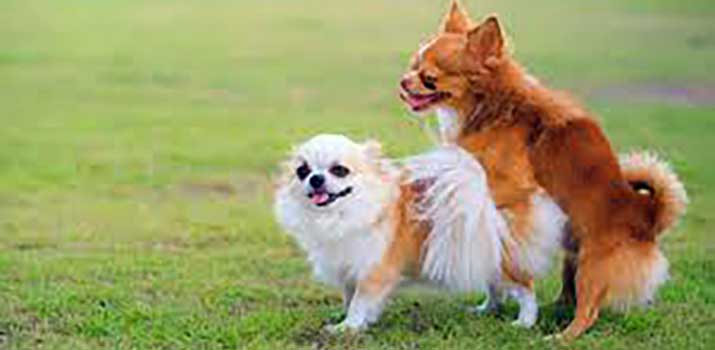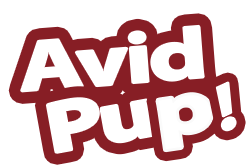
Humping is a behavior most dog owners typically don’t like to see from their canine companions. From a human standpoint, humping and mounting tend to have an overt sexual connection.
But that’s not always the case with dogs.
It’s one of the many ways dogs socialize and interact with one another. However, humping can eventually move onto objects, furniture, and even people.
There’s nothing worse than having your dog try to hump a guest who comes over! Most dog owners will scold their dogs, distract them with a toy or command, and move on.
However, humping can become a serious problem for some dogs.
What’s even more worrying is seeing young puppies start to hump.
This behavior is usually part of adulthood and plays a vital role in breeding, so it often comes as a shock when you see a tiny puppy doing it. But contrary to popular belief, this behavior isn’t exclusive to adult dogs.
Believe it or not, puppies can start far earlier than most think!
When Do Puppies Begin Humping and Mounting?
Usually, humping should become a regular thing around the time that dogs reach sexual maturity.
For most breeds, that’s around six months old. But for bigger dogs, it could be closer to two years. It all depends on how the dog develops.
While the six-month mark is the norm, you might see it much sooner. It’s not uncommon to see puppies as young as eight weeks old humping litter mates!
5 Reasons Why Young Puppies Hump
As adults, humping is a multi-faceted behavior that serves many purposes.
It’s primarily a way for dogs to prepare for future mating encounters. However, it can also serve as a way to assert dominance or show excitement.
Many of those more innocent meanings apply to puppies. Here are just a few reasons why puppies as young as eight may start humping.
1. Social Status
We’ve all heard pet experts refer to you and your family as a “pack.” That terminology isn’t just colorful verbiage.
Canines view family units as packs.
Long before domestication, dogs lived in packs with distinct hierarchies. Even today, wild canines exhibit a dedication to keeping their group safe and healthy.
Modern pups are the epitome of spoiled, but that pack mentality remains. As puppies, dogs typically view their littermates as a pack.
Eventually, it becomes you, your family, and any other pets you might have in the home.
What does this all have to do with humping? Well, dogs use mounting to show their place in the pack. It’s a form of dominance.

The strongest alpha dog will often mount and hump the weaker ones to establish some leadership. Meanwhile, the followers of the group will submit.
Humping at a young age is a way for pups to “test the waters” a bit.
It’s their attempt to try and attain that alpha status. When you think about it, the behavior is nothing more than a young puppy trying to prove itself.
However, the behavior can get problematic if it extends to you.
Some pups get so bold as to hump owners, which you should nip in the bud as soon as possible to avoid dominance issues later. We’ll go over how you can stop humping soon.
2. Innocent Play
In most cases, puppies will hump as a form of play.
It’s definitely strange from a human’s perspective, but it’s nothing but innocent fun for most rambunctious puppies.
You might see two littermates chasing each other around before taking turns mounting each other. Don’t worry: It’s only weird if you make it so!
In this case, your puppy’s behavior shows sheer excitement and happiness.
It’s a way to deal with those bubbling emotions. The act is normal in this context and is usually nothing to raise red flags.
Related: At What Age Do Pups Calm Down?
3. Unbridled Excitement
This reasoning is similar to the last, but it can pop up whenever your pup is overwhelmed with positive emotions.
For example, it could happen in the middle of a rousing play session with you or after they’ve eaten a fantastic meal.
You’re most likely to see humping in this context when you’re dealing with a hyperactive puppy.
You know the type: Young furballs that are incapable of sitting still for more than two seconds! They’re balls of energy that can’t stop.
Eventually, those emotions will reach a boiling point, and they’ll have nothing to do but hump away the happiness.
Internally, your pup is experiencing a wave of dopamine hitting the brain. The humping is simply a way to divert that energy and address an unbreakable urge.
Related: Why Is My Dog So Clingy All of a Sudden
4. Feelings of Stress
While most puppies will hump out of joy, it can also stem from more negative emotions.
Puppies have it easy, but that doesn’t mean they don’t experience stress. They’re always learning about their environment, and stressful situations come up more often than you think.
Pups tend to feel anxiety in new environments or situations.

For example, you might see your pooch freaking out whenever you go to a store or when a new person comes into your home.
In some cases, even unfamiliar noises can trigger nervousness.
Dogs aren’t very good at coping with strange feelings. That’s why they resort to destructive behavior like chewing.
All things considered, humping is a pretty innocent way to deal with those emotions.
However, the best thing you can do is address the stressor and do what you can to calm your dog.
5. Potential Medical Issues
In rare cases, puppies can hump because of medical problems. It’s not something any dog owner wants to think about, but it’s a reality that you must address.
Some common health issues that cause humping include urinary tract infections, prostate troubles, and tumors.
The humping could be a sign of pain or discomfort.
We always recommend taking your pup to a vet if you suspect health problems are to blame for any oddball behavior. It never hurts to be on the safe side.
Make a note of any other strange symptoms or behavioral changes. Any additional tidbits of information will help your vet figure out what’s going on.
Is It Normal for a Puppy to Hump, and Should You Stop It?
Humping is relatively normal behavior for young puppies. Even pups as young as eight weeks old will do it.
Generally, trainers recommend addressing it only if it becomes an issue.
Before the age of six months, a couple of humping sessions a day is a non-issue. Remember: It’s usually not sexual at that age.
Even after your dog reaches maturity, one or two fits per day are perfectly acceptable. However, if it becomes more regular, you may want to consider training to divert your dog’s attention.
Three or more humping fits is a little much and could indicate that the behavior is becoming an unhealthy habit rather than a typical dog quirk.
Of course, you can address humping sooner if it makes you uncomfortable. Humping is normal, but it’s not a necessity that dogs need to do to stay healthy.
When the behavior becomes too much for you, your family, or your guests, there’s no shame in trying to put an end to it.
Related: Why Dogs Lick Other Dogs Urine
How to Stop Humping Behavior
Teaching a young puppy to stop humping and mounting isn’t as tricky as it seems. While the behavior is instinctive, it’s something that can quickly turn into a weird habit.
Like other habits, a dog’s attitude towards humping will change based on positive or negative experiences.
Getting your dog to stop is about using positive reinforcement to redirect their attention to something else. The key is to encourage a different habit to replace the one you don’t want.
Capture Commands
One of the easiest ways to stop humping is to use capture commands. These are simple commands that work to capture your dog’s attention. They are a crucial part of any dog training routine.
They are helpful beyond humping situations. These commands can also get your dog out of pickle whenever they get into sticky situations.
What types of commands should you teach?
“Sit” is the most straightforward and universally effective. When your pup sits, they have no choice but to stop what they’re doing and pay attention!
To teach your dog to sit, give a robust verbal command and hover a treat above their eyes.
Your dog will likely sit down to get a better view of the treat. Keep providing positive reinforcement, and they’ll eventually make the connection between your verbal command and the treat.
You can even throw in a hand gesture to provide non-verbal cues.
Whenever your dog starts humping, give the “Sit” command to stop them. Later on, you can teach your dog “Come” or “Leave it.” But “Sit” is the easiest for puppies to learn.
Easy Distractions
If commands don’t work, you can always use simple distractions. Toys, treats, and other things they love work well.
Toss them at your pup whenever they start humping, and the distraction should capture their attention pretty well.
Be wary of using this technique unless it’s your only option. Using a positive distraction could inadvertently reinforce the humping.
Spaying and Neutering
Spaying or neutering is a surprisingly efficient way to curb humping behavior. It doesn’t stop it entirely.
Dogs can still feel the urge to hump even after they go through spaying or neutering procedures. However, removing the reproductive organs can make it less likely.
Hormones have a lot to do with why dogs feel the need to hump. Removing the reproductive organs essentially stops significant hormonal fluctuations.
Your dog’s behavior becomes more predictable, and widespread humping becomes a thing of the past.
Related: How Soon Can You Walk Your Dog After Neutering?
More Exercise and Play
Finally, you can wear your dog out! In the cases when emotions are to blame for humping, exercise and play could be the solution you’re after.
Physical activity is one of the best ways to control emotional outbreaks.
It doesn’t matter how your dog responds to anxiety, stress, or boredom. They are much less likely to resort to behaviors you don’t want to see when they’re worn out.
Consider going on longer walks or doing some intense play sessions. Anything that’ll get your dog moving can provide positive results.
Final Thoughts
Seeing a young puppy humping a toy or another dog can be alarming. The behavior has such a sexual connotation that it makes some owners uncomfortable. Luckily, it’s usually innocent when young puppies do it.
In most cases, it stems from stress or excitement.
As long as the humping isn’t causing issues, it’s not a big deal. But of course, you can use training to address it.
Positive reinforcement goes a long way and helps you replace humping with something a little less awkward to see
Also read: What Does it Mean When your Dog’s Balls Turn Black?

